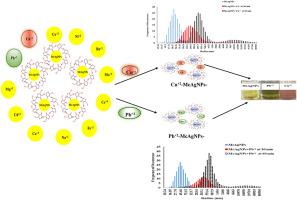当前位置:
X-MOL 学术
›
Mater. Chem. Phys.
›
论文详情
Our official English website, www.x-mol.net, welcomes your feedback! (Note: you will need to create a separate account there.)
In-situ highly selective colorimetric trace level recognition of lead and copper ion in real samples by silver nanoparticles
Materials Chemistry and Physics ( IF 4.6 ) Pub Date : 2024-03-26 , DOI: 10.1016/j.matchemphys.2024.129220 Syeda Sumra Naqvi , Humera Anwar , Beenish Ahmed , Asma Siddiqui , Muhammad Raza Shah , Syed Abid Ali
Materials Chemistry and Physics ( IF 4.6 ) Pub Date : 2024-03-26 , DOI: 10.1016/j.matchemphys.2024.129220 Syeda Sumra Naqvi , Humera Anwar , Beenish Ahmed , Asma Siddiqui , Muhammad Raza Shah , Syed Abid Ali

|
In the current study, an advanced and highly discriminating scheme was developed to detect Pb and Cu using Maltol-capped silver nanoparticles (McAgNPs). Various metal ions i.e. Fe, Ce, Ni, Mg, Cd, Mo, Zn, Na, Co, Ba, Cu, and Pb was studied, among them, only Pb and Cu caused substantial changes in solution color, shifting from yellow to green and pink immediately after adding AgNPs. This color transformation was accompanied by the emergence of new visible bands at 674 nm for Pb and 608 nm for Cu. The characterization of complexes (McAgNPs-Pb and McAgNPs-Cu) was carried out by state of art techniques such as visible spectrophotometry, Fourier transform infrared spectroscopy (FTIR), and Atomic force microscopy (AFM). AFM results indicated an increase in particle size after the interaction (i.e., 40 to 150 (Cu) and 250 nm (Pb)). McAgNPs are remarkably selective for Pb and Cu in the presence of other metal ions (i.e., Fe, Ce, Mg, Ni, Mo, Zn, Cd, Co, Na, Ba). The pH effect on both complexes was also investigated over a range of pH 1.0–13.0, revealing that McAgNPs-Pb remained stable across the entire pH range, while McAgNPs-Cu was stable only under acidic conditions. Both interactions exhibited good linearity (0.4–1.0 μM), binding stoichiometry (1-Pb:1McAgNPs and 2-Cu:3McAgNPs), and their respective limit of detection (LOD) was found to be 0.035 for McAgNPs-Cu and 0.067 μM for McAgNPs-Pb. Additionally, the suggested scheme was effectively utilized to detect Pb and Cu in environmental (e.g., lake, tap, mineral, and well water) and biological (e.g., urine and plasma) samples, with recoveries ranging from 94.7 to 105%. Consequently, our approach paves the way for creating innovative and efficient suitable nanoprobe for highly selective and sensitive sensing.
中文翻译:

银纳米颗粒对实际样品中铅和铜离子的原位高选择性比色痕量水平识别
在当前的研究中,开发了一种先进且具有高度辨别力的方案,使用麦芽酚封端的银纳米粒子 (McAgNP) 来检测 Pb 和 Cu。对Fe、Ce、Ni、Mg、Cd、Mo、Zn、Na、Co、Ba、Cu、Pb等多种金属离子进行了研究,其中只有Pb和Cu引起溶液颜色发生显着变化,从黄色变为绿色添加 AgNP 后立即呈粉红色。这种颜色转变伴随着 Pb 的 674 nm 和 Cu 的 608 nm 处新可见带的出现。配合物(McAgNPs-Pb 和 McAgNPs-Cu)的表征是通过可见分光光度法、傅里叶变换红外光谱 (FTIR) 和原子力显微镜 (AFM) 等最先进的技术进行的。 AFM 结果表明相互作用后颗粒尺寸增加(即 40 至 150 nm(Cu)和 250 nm(Pb))。在其他金属离子(即 Fe、Ce、Mg、Ni、Mo、Zn、Cd、Co、Na、Ba)存在下,McAgNP 对 Pb 和 Cu 具有显着的选择性。还在 pH 1.0–13.0 范围内研究了 pH 对两种复合物的影响,结果表明 McAgNPs-Pb 在整个 pH 范围内保持稳定,而 McAgNPs-Cu 仅在酸性条件下稳定。两种相互作用均表现出良好的线性 (0.4–1.0 μM)、结合化学计量(1-Pb:1McAgNPs 和 2-Cu:3McAgNPs),并且发现它们各自的检测限 (LOD) 对于 McAgNPs-Cu 为 0.035,对于 0.067 μM。 McAgNPs-Pb。此外,所提出的方案还有效地用于检测环境(例如湖水、自来水、矿泉水和井水)和生物(例如尿液和血浆)样品中的 Pb 和 Cu,回收率范围为 94.7% 至 105%。因此,我们的方法为创建创新且高效的合适纳米探针以实现高选择性和灵敏传感铺平了道路。
更新日期:2024-03-26
中文翻译:

银纳米颗粒对实际样品中铅和铜离子的原位高选择性比色痕量水平识别
在当前的研究中,开发了一种先进且具有高度辨别力的方案,使用麦芽酚封端的银纳米粒子 (McAgNP) 来检测 Pb 和 Cu。对Fe、Ce、Ni、Mg、Cd、Mo、Zn、Na、Co、Ba、Cu、Pb等多种金属离子进行了研究,其中只有Pb和Cu引起溶液颜色发生显着变化,从黄色变为绿色添加 AgNP 后立即呈粉红色。这种颜色转变伴随着 Pb 的 674 nm 和 Cu 的 608 nm 处新可见带的出现。配合物(McAgNPs-Pb 和 McAgNPs-Cu)的表征是通过可见分光光度法、傅里叶变换红外光谱 (FTIR) 和原子力显微镜 (AFM) 等最先进的技术进行的。 AFM 结果表明相互作用后颗粒尺寸增加(即 40 至 150 nm(Cu)和 250 nm(Pb))。在其他金属离子(即 Fe、Ce、Mg、Ni、Mo、Zn、Cd、Co、Na、Ba)存在下,McAgNP 对 Pb 和 Cu 具有显着的选择性。还在 pH 1.0–13.0 范围内研究了 pH 对两种复合物的影响,结果表明 McAgNPs-Pb 在整个 pH 范围内保持稳定,而 McAgNPs-Cu 仅在酸性条件下稳定。两种相互作用均表现出良好的线性 (0.4–1.0 μM)、结合化学计量(1-Pb:1McAgNPs 和 2-Cu:3McAgNPs),并且发现它们各自的检测限 (LOD) 对于 McAgNPs-Cu 为 0.035,对于 0.067 μM。 McAgNPs-Pb。此外,所提出的方案还有效地用于检测环境(例如湖水、自来水、矿泉水和井水)和生物(例如尿液和血浆)样品中的 Pb 和 Cu,回收率范围为 94.7% 至 105%。因此,我们的方法为创建创新且高效的合适纳米探针以实现高选择性和灵敏传感铺平了道路。



























 京公网安备 11010802027423号
京公网安备 11010802027423号